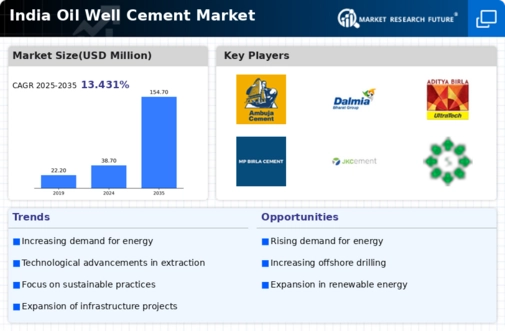The oil well-cement market in India is characterized by a competitive landscape that is increasingly shaped by innovation, strategic partnerships, and a focus on sustainability. Key players such as Halliburton (US), Schlumberger (US), and Baker Hughes (US) are actively pursuing strategies that emphasize technological advancements and operational efficiencies. Halliburton, for instance, has been focusing on enhancing its cementing technologies to improve well integrity and reduce environmental impact, which appears to resonate well with the growing demand for sustainable practices in the industry. Meanwhile, Schlumberger has been investing in digital transformation initiatives, aiming to leverage data analytics to optimize cementing operations, thereby enhancing performance and reducing costs. These strategies collectively contribute to a competitive environment that is not only dynamic but also increasingly aligned with global sustainability goals.
In terms of business tactics, companies are localizing manufacturing and optimizing supply chains to enhance responsiveness to market demands. The competitive structure of the oil well-cement market in India is moderately fragmented, with several players vying for market share. However, the influence of major companies like National Oilwell Varco (US) and LafargeHolcim (CH) is significant, as they leverage their extensive resources and technological capabilities to maintain a competitive edge. This fragmentation allows for niche players to emerge, yet the dominance of established firms shapes overall market dynamics.
In October 2025, Baker Hughes (US) announced a strategic partnership with a leading Indian energy firm to develop advanced cementing solutions tailored for the local market. This collaboration is expected to enhance Baker Hughes' market presence while providing innovative solutions that cater to the specific needs of Indian oil and gas operators. The strategic importance of this partnership lies in its potential to drive technological advancements and improve operational efficiencies in cementing processes, thereby positioning Baker Hughes favorably in a competitive landscape.
In September 2025, National Oilwell Varco (US) launched a new line of eco-friendly cement products designed to minimize environmental impact during drilling operations. This initiative reflects a growing trend towards sustainability within the industry, as operators increasingly seek to comply with stringent environmental regulations. The introduction of these products not only enhances NOV's product portfolio but also aligns with the broader industry shift towards greener practices, potentially attracting environmentally conscious clients.
In August 2025, LafargeHolcim (CH) expanded its operations in India by establishing a new manufacturing facility dedicated to producing high-performance oil well-cement. This strategic move is indicative of the company's commitment to meeting the rising demand for specialized cement solutions in the region. The facility is expected to enhance LafargeHolcim's production capacity and reduce lead times, thereby strengthening its competitive position in the market.
As of November 2025, current trends in the oil well-cement market are increasingly defined by digitalization, sustainability, and the integration of artificial intelligence (AI) into operational processes. Strategic alliances are becoming more prevalent, as companies recognize the value of collaboration in driving innovation and enhancing supply chain reliability. Looking ahead, competitive differentiation is likely to evolve from traditional price-based competition towards a focus on technological innovation and sustainable practices. This shift underscores the importance of adaptability and forward-thinking strategies in navigating the complexities of the oil well-cement market.



















Leave a Comment